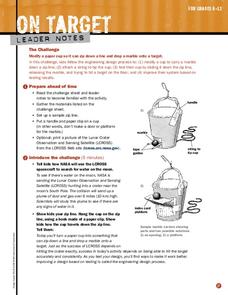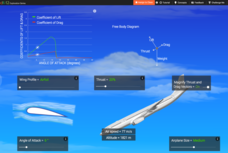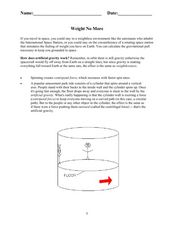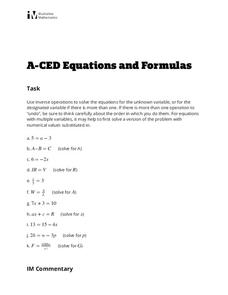Curated OER
MEASURING THE GRAVITATIONAL CONSTANT, G
Students study gravitational force an. In this gravitational force lesson students observe a demonstration.
LABScI
Potential and Kinetic Energy: The Roller Coaster Lab
Ron Toomer, a famous roller coaster designer, suffered from motion sickness. Pupils design their own roller coasters, learning about potential and kinetic energy in the process. Labs focus on the importance of drop height, energy...
Curated OER
Newtonian Mechanics
Students familiarize themselves, through teacher demonstration, with Gavendish's apparatus first used for experimentally determining the value of the Universal Gravitational Constant G, and calculate theoretical value of Earth's...
Rice University
College Physics for AP® Courses
Take a look at an organized physics course. The 34-section electronic textbook covers material in AP® Physics 1 and 2. Teachers use the text to supplement lectures and have the class work through the labs. Each section contains multiple...
Teach Engineering
The Great Gravity Escape
Groups simulate an orbit using a piece of string and a water balloon. Individuals spin in a circular path and calculate the balloon's velocity when the clothes pin can no longer hold onto the balloon.
Cornell University
Alka-Seltzer Rockets
Blast off! An engaging hands-on activity has pupils create rockets powered by Alka-Seltzer. They learn about the physics behind these rockets throughout the process.
Curated OER
A Classical & Relativistic Trip to a Black Hole
Students calculate distance, velocity, acceleration and time on their fantasy trip to the black hold. They apply Newton's Laws of Motion and calculate circular motion. They discuss any questions that may arise.
Curated OER
Kepler's Third Law
High schoolers use Kepler's third law to derive the velocity in a circular orbit of any radius, and identify the Earth escape velocity.
American Museum of Natural History
Meet the Universe's Main Attraction ... Gravity
Learners read a short description about gravity and what it does and then explore the two ideas about how gravity works. After gaining a better understanding of the concept, individuals participate in a thorough experiment on what would...
Tech Museum of Innovation
Balloon Astronaut
Design protection from high-speed particles. The STEM lesson plan highlights why astronauts need protection from space debris. Pupils use the design process to design, build, and test a spacesuit that will protect a balloon from a...
Curated OER
The Inertial Balance
Students weigh objects using a triple beam balance. In this mass lesson, students use an inertial balance made with a metal rod to measure and graph vibrations of varying numbers of pennies in a bucket. References and discussion prompts...
Curated OER
Johannes Kepler
In this online interactive history worksheet, students respond to 10 short answer and essay questions about the achievements of Johannes Kepler. Students may check some of their answers on the interactive worksheet.
CK-12 Foundation
Elevator
Do you weigh slightly less when an elevator first starts its descent? The simulation teaches the change in the force based on the acceleration, constant speed, or deceleration of an elevator. Scholars control the mass and acceleration...
NASA
On Target
NASA's LCROSS mission is dropping a probe into a lunar crater. Groups design a system to travel down a zip line and drop a marble onto a target in the classroom. The groups then modify their designs based upon testing.
CK-12 Foundation
Airplane
How does an airplane control its take off and descent? Scholars explore the forces acting on an airplane and control the angle of attack, wing profile, thrust, and airplane size. They learn about lift, drag, thrust, gravity, and the...
Curated OER
Weight No More
Students relate the concept of gravity to math. In this algebra lesson plan, students define scientific terminology relative to gravity, weight and centripetal force. They measure the different dimensions of a cylinder as they discuss...
Curated OER
History of Astronomy
Students participate in assessments regarding the history of astronomy. They listen and take notes, draw a time line, draw a solar sytem designed by Ptolemy and create flashcards. They write an essay on Galileo, watch a video, take a...
Illustrative Mathematics
Equations and Formulas
Your class is asked to use inverse operations to solve eleven equations for unknown variables or to rearrange formulas to highlight a quantity of interest. By using the same reasoning as solving one- and two-step equations, algebra...
Curated OER
Applied Science - Built Environment (6) Lab
Sixth graders look at toys in space. In this gravity lesson, 6th graders make predictions about what different toys will do with zero gravity. They watch a space video and see what happens to these toys in space.
E Reading Worksheets
Main Idea Worksheet 5
Did you know that Marie Curie's papers, as well as her cookbook, are radioactive and stored in lead-lined boxes? Did you know that Nikola Tesla developed a death ray? Famous scientists and inventors are the subjects featured in a series...
Curated OER
Speed
Fifth and sixth graders practice working in pairs to determine whether they can walk with constant speed. They test themselves, collect their data, draw graphs with their data collected, manipulate the data, and then draw conclusions...
American Chemical Society
Joseph Priestley, Discoverer of Oxygen
Do you want to hear a joke about nitrogen and oxygen? NO. We all know there is oxygen in the air and that plants produce oxygen, but how was it discovered? Scholars read a handout, answer questions, and analyze material in the...
Curated OER
Intellectual History
In this online interactive world history instructional activity, learners answer 22 matching questions regarding the Enlightenment. Students may submit their answers to be scored.
Curated OER
Physics Rules and S.I. Units Game
In this physics rules worksheet, students complete questions and answers in order to review physics rules with each other. Students complete 26 questions.

























